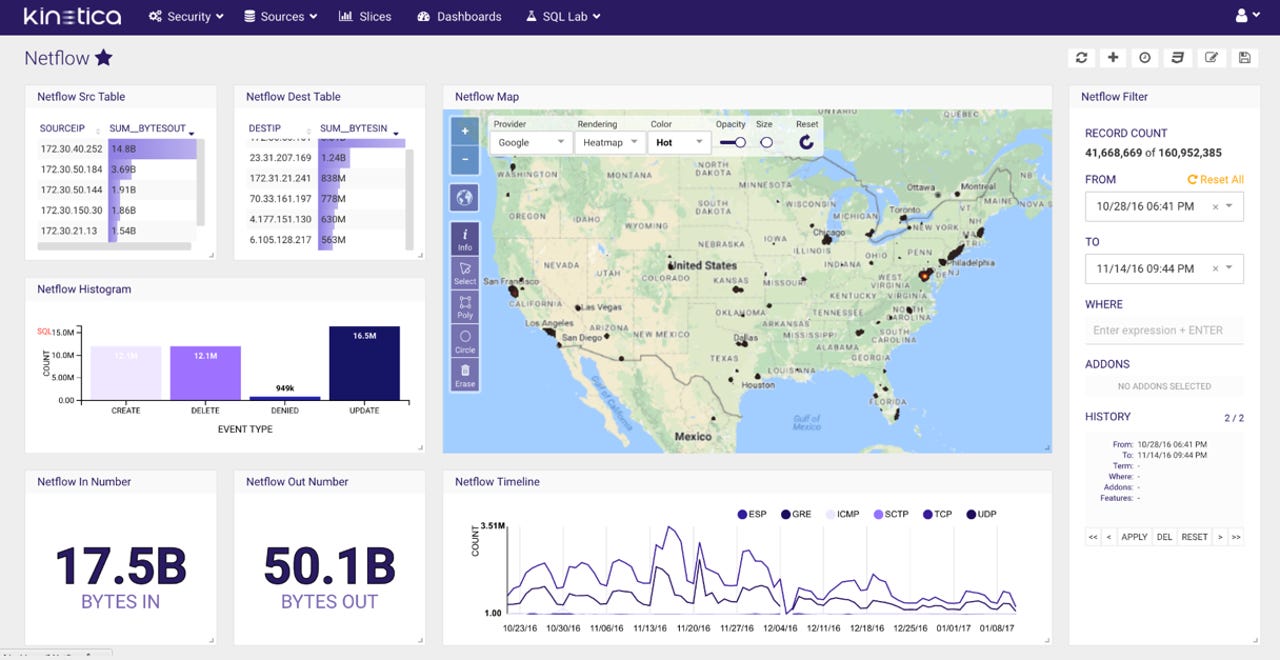Qlik announces SMB cloud solution; Kinetica combines AI and BI

The analytics world continues to add breakthrough technologies, provide more integrated offerings and package them up for use by both large and small organizations.
Qlik, which just recently announced that it was acquiring GIS player Idevio and integrating location analytics capabilities into its product, is now taking its Qlik Sense Cloud offering and making it available to a broader audience. Previously available for Enterprise customers, the Software as a Service (SaaS) offering is now available to small and medium businesses (SMBs), groups and teams as Qlik Sense Cloud Business.
Qlik's nitty gritty
Unlike Qlik's original QlikView product, which provides a native desktop interface, Qlik Sense sports an HTML 5 Web browser-based interface and, as such, is well-suited to packaging in SaaS form. Qlik is apparently very serious about the cloud. In its press release on the SMB offering, it refers to Qlik Sense as "a micro-services platform designed for the cloud" and "an extensible, cloud-first platform."
Also read: QlikView 12 vs Qlik Sense Cloud: An overview
The offering includes group-based work areas, data spaces and shared networks. The service also offers one-click sharing, both to users internal to the organization and those who may be external as well.
Qlik Sense Cloud Business is available now and is priced at $25 per user per month. That comes in at the pricing mid-range in self-service cloud Business Intelligence (BI), given that Tableau Online's fees work out to $41.67/user/month (based on its $500/user annual price) and Microsoft's Power BI Pro is $9.99/user/month.
Kinetica
San Francisco-based Kinetica, rather than moving you from earth-bound CPUs to cloud-based ones, moves workloads out of the CPU entirely, having them run on the graphical processing unit (GPU) instead.
GPUs are, as the name would imply, designed to help accelerate graphical rendering on machines, and they come in especially handy for games. BI is no game, but since both graphics acceleration and analytics are all about math, GPUs tend to work well for both and, in the analytics realm, especially well for Machine Learning (ML) and Artificial Intelligence (AI).
While Kinetica is a GPU-accelerated in-memory database, it's not an ML/AI platform per se, or it least it hasn't been. But Kinetica is today announcing a few new features that make its use as such a platform pretty compelling.
UDFs FTW
First off, Kinetica is adding in-database user-defined functions (UDFs) to the product. Kinetica UDFs can be written in C++ or Java and then called from SQL queries as if they were functions built into the SQL language. And with a C++/Java-based environment, a whole range of ML/AI libraries can be used to be train ML models with data in a Kinetica database and/or allow such data to be scored against existing models.
Since Kinetica is an in-memory database, such operations go pretty fast. But another newly announced feature makes them go faster still: Kinetica's so called VRAM Boost Mode, which lets Kinetica pin data in the GPU's own memory, rather than having to use only system memory. GPU memory, known as Video Random Access Memory (hence the VRAM acronym) is much faster than system RAM since GPU-accelerated operations have direct access to the former and don't need to move data between it and system RAM.
Whole greater than sum?
Put all of this (GPU acceleration, UDFs and VRAM usage) together, and you end up with a system that can train ML models and score data with them very quickly. While other VRAM-based systems exist, Kinetica's VP, Global Solution Engineering, Eric Mizell, tells me they are typically single-node systems and use VRAM -- which is limited in capacity -- exclusively, leaving Kinetica far more scalable.

A screen shot of Kinetica's Reveal visualization framework
And with all that scalability available, Kinetica is also announcing the addition of a visual data discovery front-end it calls the Reveal visualization framework. Reveal provides for end-user access to Kinetica, which up until now has been deployed as a database engine, without an end-user interface.
Reveal also adds specific geographical/location analytics capabilities and takes advantage of the GPU to render map-based visuals -- like the one in the image above -- on the server, relieving burdens on client machines and allowing the plotting of a much larger data sets.
Come together?
While these two announcements may seem orthoganal, in fact the cloud and GPU technology are coming together. Amazon's Cluster GPU Instances, Microsoft Azure NC virtual machines, and the Google Cloud Platform GPU alpha program are making this a reality, now. Pretty soon, GPU-accelerated BI and AI, in the cloud, will likely be a few clicks (and credit card charges) away.
But for now, these announcements from Qlik and Kinetica move us along nicely, thank you.